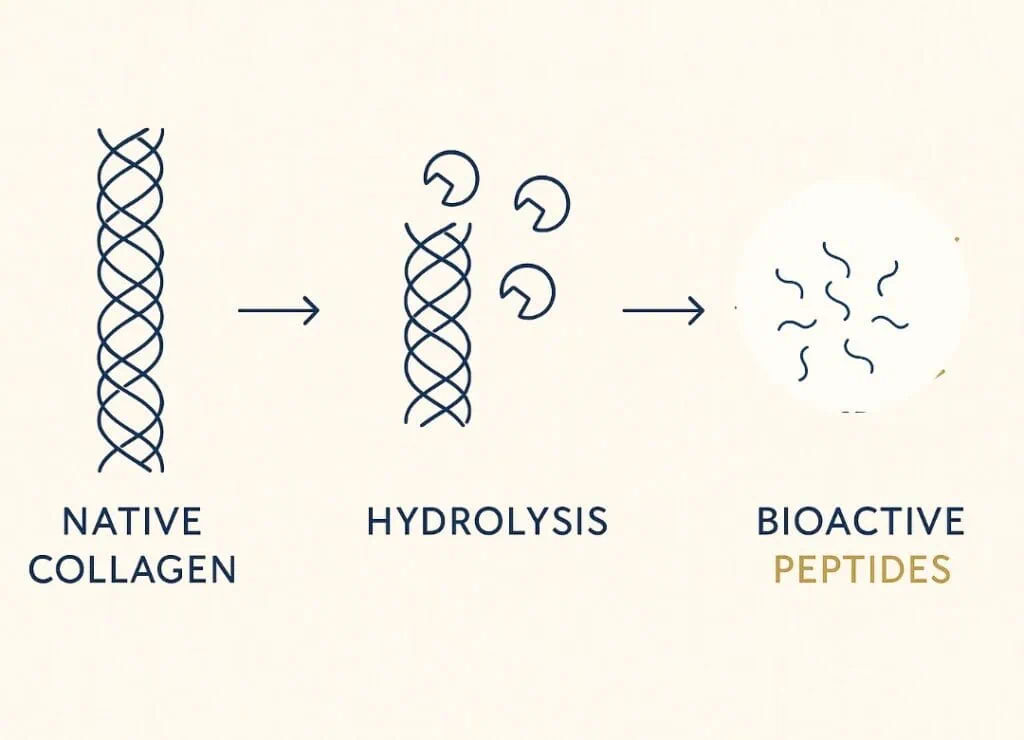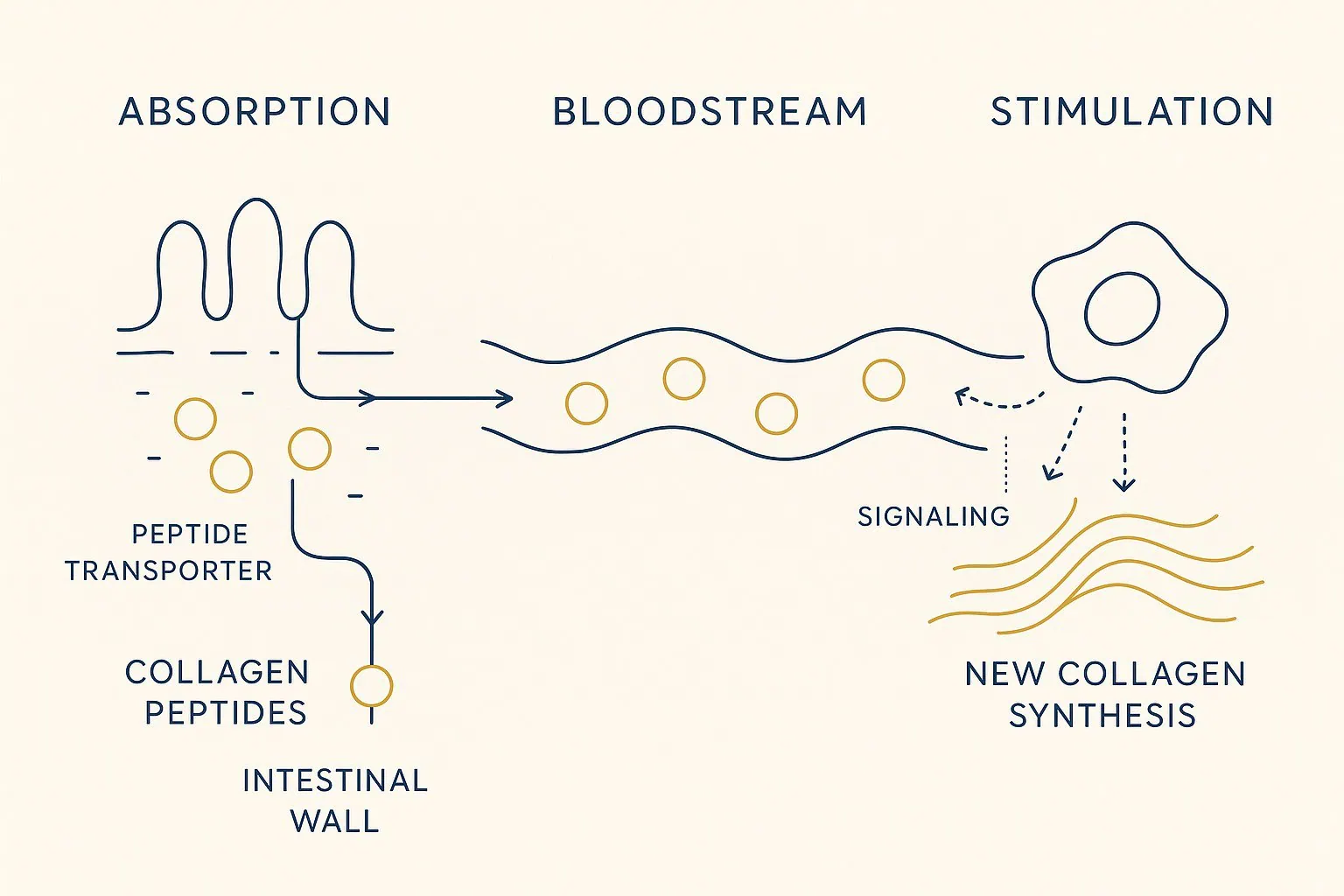Collagen isn’t a single fix for every concern — it’s a biological material that supports different tissues through different pathways. Its results depend on formulation design: blends optimized for collagen synthesis, joint resilience, or skin renewal each emphasize distinct cofactors and peptide profiles. Understanding how collagen actually works helps you choose formulations that meet your body’s specific needs.
- Skin: Most high-quality RCTs show moderate-to-strong improvements in hydration and elasticity after 8–12 weeks (SMD ≈ 0.6 – 0.7).
- Benefits: Appear more gradually — measurable improvement in comfort and function after 24–48 weeks of sustained use.
- Peptide size < 3 kDa: Greater bioavailability and signalling to fibroblasts and chondrocytes.
This article provides a balanced, evidence-based look at whether oral collagen supplements – specifically the commonly studied hydrolyzed collagen peptides – genuinely offer benefits for different health areas, with a particular focus on skin health.

How Collagen Supplements Work—From Protein to Peptide
Native collagen, found naturally in animal tissues (like bovine collagen / beef collagen or marine collagen), is a very large protein molecule (around 300 kDa, think of kDa as a unit measuring the size or weight of these tiny protein pieces; a high kDa means a large molecule, and a low kDa means a small one). While beneficial when consumed in foods like bone broth (providing amino acids), its sheer size limits its direct absorption. Collagen cannot be absorbed in its whole form and must be broken down into smaller components for the body to use.
Uncover Advanced Protocols and Launch Access.
For those who champion evidence over hype.
High-quality supplements use enzymatic hydrolysis – a controlled process using specific enzymes to break down the large collagen protein into much smaller chains called collagen peptides (CP), also known as hydrolyzed collagen (HC), [León-López et al., 2019]. These peptides typically have a low molecular weight (often below 5kDa, with many products aiming for <3kDa), which is key to their potential effectiveness.

Absorption & Bioavailability: Getting Peptides into Your System
Why are smaller peptides better?
Because they can be more easily absorbed by your body. Unlike the large native collagen molecule, which is mostly broken down into individual amino acids during digestion, studies show that specific small collagen peptides (especially di- and tri-peptides containing the key amino acid hydroxyproline, like Pro-Hyp) can be absorbed partially intact through the intestinal wall into the bloodstream. They use specialized ‘doorways’ in the gut lining, known as peptide transporters [Inacio et al., 2024], like PEPT1, which allow these short chains to pass through more readily than large proteins. Think of it like having a special VIP entrance just for these specific small peptides, allowing them to reach the bloodstream effectively.
Why is this effective absorption relevant?
Because many of these small peptides are considered ‘bioactive’. This means that beyond simply providing protein building blocks, they can have specific biological effects, such as sending signals to cells to boost the production of substances like collagen. Think of them as having a dual effect – providing raw materials and acting as crucial messengers.

Signaling Fibroblasts (and other cells): The Proposed Mechanism of Action
Certain peptide fragments—especially Pro-Hyp and Gly-Pro-Hyp—do more than supply amino acids. They act like molecular cues that dermal fibroblasts (skin) and chondrocytes (cartilage) interpret as a signal to synthesize extracellular matrix components: collagen, elastin, and hyaluronic acid, [Inacio et al., 2024]
In parallel, signalling down-regulates matrix metalloproteinases (MMPs), the enzymes that degrade collagen. The net effect is a shift toward renewal, not an overnight transformation.Once absorbed, these bioactive peptides circulate throughout the body and reach target tissues like the skin, joints, and bones. [Edgar et al., 2018]
Tissue Timeframes
Skin dermis remodels on the order of weeks to months; cartilage turns over more slowly. That’s why skin changes are typically visible by weeks 8–12, while joint comfort/function tends to improve with longer, consistent supplementation (several months).
What matters / what doesn’t :
• Matters: hydrolysis quality, peptide size (≤ 3 kDa), total daily dose, and adherence.
• Doesn’t matter as much: source “myths” (fish vs bovine) once size and dose are matched
What is Collagen? (A Quick Refresher)
Collagen represents roughly 30% of total protein mass, acting as the architectural scaffold for skin, bone, tendons, ligaments, and vessels. There are at least 28 known types of collagen, but the most important for human health are Types I, II, III, and IV.
- Type I (with Type III) dominates skin and connective tissue, conferring tensile strength and elasticity.
- Type II is central to cartilage, supporting joint cushioning and smooth motion.
- Type IV forms basement membranes that separate and support tissue layers.
Age-related decline. Endogenous collagen synthesis falls by ~1–1.5% per year from the mid-20s; after menopause, skin collagen can drop by ~30% within five years. This doesn’t mandate supplementation, but it explains why precision nutrition (including vitamin C and selected co-factors) can make a visible difference in mid-life.
What Does the Clinical Evidence Show? (Skin, Joints & More)
The theory of peptide signalling is compelling — but how well is it supported in human trials?
To answer that fairly, we look at the highest tier of evidence available: randomised controlled trials (RCTs) and their aggregated form, systematic reviews and meta-analyses.
Science advances not by miracle claims, but by the patient accumulation of moderate truths.
Skin Health — Hydration, Elasticity & Wrinkles
Across multiple Meta-Analyses (Pu et al., 2023) published between 2019 and 2023, oral hydrolysed collagen peptides (2.5 – 10 g daily for 8 – 12 weeks) produced moderate, statistically significant improvements in skin hydration and elasticity compared with placebo.
The pooled effect sizes (SMD ≈ 0.6–0.7) translate to visibly smoother and better-hydrated skin — not transformation, but measurable biological change.
Mechanistically, these low-molecular-weight peptides (< 3 kDa) appear to stimulate dermal fibroblasts to produce new collagen and hyaluronic acid, while modestly suppressing MMP-1 activity that breaks collagen down.
Wrinkle-depth reduction has been documented in several high-quality RCTs after 12 weeks of continuous intake, though magnitude varies by age and baseline photodamage.
Effects plateau around the 3-month mark, suggesting that consistency, not dose escalation, is the key driver.
A meta-analysis is a powerful type of research that statistically combines the results from multiple independent studies on the same topic, providing a stronger overall conclusion than any single study alone.
Evidence for Joint Health
Type II collagen and mixed bovine or porcine peptide formulas have been studied in osteoarthritis and exercise-induced joint stress.
Improvements in pain and mobility are typically observed after 12 – 24 weeks of daily supplementation (5 – 10 g collagen peptides or ~40 mg undenatured Type II).
While outcomes are encouraging, variability in cartilage scoring and subjective pain metrics makes the certainty of evidence moderate.
The pattern is clear, though: benefit builds slowly with adherence rather than dosage spikes.
Evidence for Bone Health
Type I collagen is the dominant protein in bone matrix.
In post-menopausal women, year-long trials using 5 g daily collagen peptides have shown increases in bone mineral density (BMD) and decreases in bone turnover markers.
The mechanism mirrors dermal renewal: peptide signalling of osteoblasts, improved collagen framework, and subsequent mineral deposition.
These findings are promising but still limited by small sample sizes and lack of long-term (> 2 years) data. [König et al., 2018)].

Gut Barrier & Microbiome
Collagen provides amino acids such as glycine and glutamine that support intestinal mucosa.
Animal studies suggest certain collagen peptides may improve barrier integrity and modulate microbiota composition, but controlled human data are preliminary.
It is more accurate to say collagen contributes the building blocks for gut lining maintenance rather than acts as a targeted prebiotic.
Muscle Mass & Performance
Because collagen is low in leucine, it has minimal impact on muscle protein synthesis compared with complete proteins such as whey or soy isolate.
However, trials combining collagen with resistance training in older adults have shown small but meaningful gains in fat-free mass and strength — likely due to improved connective-tissue resilience rather than direct anabolic stimulation.
Collagen’s role in wound healing is also well-documented. The amino acids in collagen are vital for tissue repair, making collagen supplements a potential aid for faster recovery from injuries or surgery.
Phillips (2014), McMaster University — Whey vs. Collagen
In controlled trials comparing protein sources, Phillips’ group showed that collagen lacks enough leucine to strongly activate the mTOR pathway, which is central to muscle protein synthesis.
Interpretation: collagen supports connective-tissue resilience rather than direct muscle growth — its strength lies in the scaffolding, not the muscle fibres themselves.
Do Collagen Drinks & Powders Improve Skin?
Most successful clinical trials involve participants consuming hydrolyzed collagen peptides that have been dissolved in liquid – whether provided as a ready-made drink or a powder mixed into water or another beverage. This confirms that oral intake in liquid form is an effective delivery method for achieving the observed skin benefits. Products like collagen liquid, collagen powder, liquid collagen drink, or collagen sachets are common formats.
The effectiveness of liquid marine collagen or bovine collagen powder depends on the quality of the hydrolysis process and bioavailability of the peptides themselves once ingested. Read more about the hydrolysis process and assesing collagen quality in our article Marine vs Bovine Collagen.
Dose, Timing, and Practical Use
Effective Dose Range
Most clinical protocols use 2.5–10 g/day of hydrolysed collagen peptides. Many show significant outcomes even at the lower end (~2.5 g/day), provided the peptides are small (≤ 5 kDa) and the regimen is daily. [Pu et al., 2023].
When to take? Time of day is less important than consistency. Some prefer morning with vitamin C; others split dose AM/PM. With or without food is acceptable, though users seeking GI comfort may prefer with food.
How Long to Continue
- Skin: plan for 8–12 weeks to evaluate hydration/elasticity, then reassess at 16 weeks.
- Joints: plan for 24+ weeks of steady intake; benefits track with the slower biology of cartilage.
- Bone: evaluate only at 12 months, alongside adequate dietary protein and minerals.
Across studies: 2.5–10 g/day × 8–12 weeks → measurable gains in hydration & elasticity.
Adherence heuristics
Single-serve sticks remove friction. Flavourless versions dissolve into water, tea, coffee, or smoothies. Set a recurring reminder—results trace to routine. You can read more about How Long it Takes for Collagen to Work in our dedicated article, and if you want to learn more about how to choose the best collagen supplement for you, read our Marine vs Bovine Collagen Supplements.
Collagen Supplements: Funding and Publication Bias
A large proportion of collagen research is industry-sponsored, often by the raw-material manufacturers themselves.
That doesn’t invalidate the results, but it introduces a structural bias: trials funded by suppliers tend to publish positive outcomes more frequently than independent ones.
Negative or neutral findings are less likely to appear in print — a phenomenon known as publication bias.
High-quality meta-analyses now attempt to account for this, yet transparency about data access remains inconsistent.
At Vita Katalyst we consider this context part of the science itself — not an afterthought.
Study Design Limitations
- Sample size: Many RCTs enrol fewer than 100 participants; statistical power is limited.
- Duration: Typical study length (8 – 12 weeks) may not capture long-term physiological adaptation.
- Population bias: Most studies use healthy women aged 35 – 60; data for men, diverse ethnicities, or clinical populations are sparse.
- Heterogeneity: Different peptide sources, hydrolysis degrees, and outcome measures make direct comparison difficult.
Recognising these boundaries is what allows us to read “significant improvement” with nuance — significant doesn’t always mean dramatic.
Product Quality & Label Transparency
In the UK and EU, collagen supplements are classified as food supplements, not medicinal products. They do not require pre-market approval for efficacy like medicines do.
Quality therefore depends on manufacturer integrity.
Key indicators of reliability:
- Disclosed peptide molecular-weight distribution (ideally ≤ 3 kDa).
- Availability of a third-party Certificate of Analysis (COA) verifying purity and heavy-metal testing.
- Transparent sourcing — specifying bovine, porcine, or marine origin and country of manufacture.
Realistic Expectations
Collagen is not an instant transformation tool; it’s a nutritional signal that supports tissues already engaged in renewal.
Expect visible changes gradually (8 – 12 weeks for skin, 24 + weeks for joints).
The Balanced View
Taken together, the evidence base for collagen is solid enough to justify use, provided one appreciates its scope and limitations.
It is neither a miracle molecule nor a myth — it’s a biologically credible adjunct in a lifestyle that already respects diet, micronutrients, and recovery.
Collagen is not perfection bottled; it is the architecture of resilience restored.

Be first to try our evidence-built formulations.
Collagen Cofactor Complex + Cellular Triad Glutathione Complex.
No noise. No guesswork. Just biologically honest design.
Frequently Asked Questions (FAQs)
Typically 8-12 weeks of consistent daily use are needed to see noticeable improvements in skin elasticity and wrinkles, although hydration might improve slightly sooner (~4 weeks). This addresses how long for collagen to work for skin. You can read more about the timeline and what to expect in our dedicated article here.
Based on studies typically lasting up to 12 weeks, hydrolyzed collagen peptides are generally considered safe for most healthy adults. Minor side effects like bloating can occasionally occur. Choosing reputable brands with purity testing for their collagen powder or liquid collagen drink products is advisable. Always look for brands that offer transparency when it comes to ingrediants and consult your doctor if you have health conditions or concerns.
For skin health, current evidence from meta-analyses suggests minimal significant difference in efficacy between high-quality hydrolyzed sources like bovine collagen and marine collagen. Processing (low MW peptides) is likely more critical for absorption than whether it’s beef collagen or marine. Read more in our Marine vs Bovine Collagen Guide.
It’s wise to be discerning. Look for findings supported by systematic reviews or meta-analyses. Be aware that some individual studies are funded by supplement manufacturers, which means results should be interpreted carefully. Focus on consistent findings across multiple studies and maintain realistic expectations about the moderate level of benefits typically observed when looking at collagen supplements before and after studies.
In the UK, you can find various forms including collagen powder, collagen liquid, collagen sachets uk, liquid marine collagen uk, marine collagen powder uk, and liquid collagen drink options, sourced from bovine collagen, marine, and occasionally beef collagen peptides. Look for hydrolysed bovine collagen or other hydrolysed sources for best absorption.



